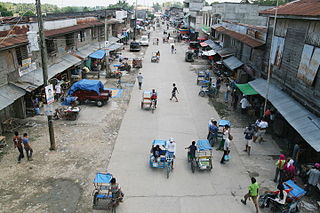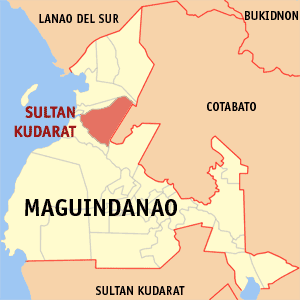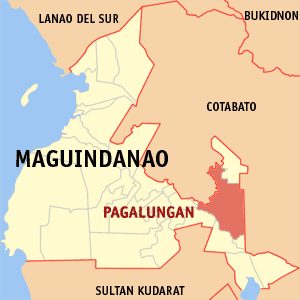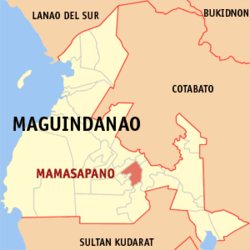
Maguindanao is a province in the Philippines located in the Bangsamoro Autonomous Region in Muslim Mindanao (BARMM). Since 2014 the provincial capital is Buluan but the legislative branch of the provincial government, the Sangguniang Panlalawigan, convenes in the old provincial capitol in the town of Sultan Kudarat. It borders Lanao del Sur to the north, Cotabato to the east, Sultan Kudarat to the south, and the Illana Bay to the west.

The Autonomous Region in Muslim Mindanao was an autonomous region of the Philippines, located in the Mindanao island group of the Philippines, that consisted of five predominantly Muslim provinces: Basilan, Lanao del Sur, Maguindanao, Sulu, and Tawi-Tawi. It was the only region that had its own government. The region's de facto seat of government was Cotabato City, although this self-governing city was outside its jurisdiction.

Buluan, officially the Municipality of Buluan, is a 4th class municipality and capital of the province of Maguindanao, Philippines. According to the 2015 census, it has a population of 50,008 people.

Datu Abdullah Sangki, officially the Municipality of Datu Abdullah Sangki, is a — municipality in the province of Maguindanao, Philippines. According to the 2015 census, it has a population of 23,878 people.

Datu Odin Sinsuat, officially the Municipality of Datu Odin Sinsuat, is a 2nd class municipality in the province of Maguindanao, Philippines. According to the 2015 census, it has a population of 99,210 people.

Datu Piang, officially the Municipality of Datu Piang, is a 2nd class municipality in the province of Maguindanao, Philippines. According to the 2015 census, it has a population of 25,600 people.

Shariff Aguak, officially the Municipality of Shariff Aguak, is a 3rd class municipality in the province of Maguindanao, Philippines. According to the 2015 census, it has a population of 31,692 people.

Sultan Kudarat, officially the Municipality of Sultan Kudarat, is a 1st class municipality and capital of the province of Maguindanao, Philippines. According to the 2015 census, it has a population of 95,201 people.

Talayan, officially the Municipality of Talayan, is a 4th class municipality in the province of Maguindanao, Philippines. According to the 2015 census, it has a population of 30,032 people.

Upi, officially the Municipality of Upi, is a 1st class municipality in the province of Maguindanao, Philippines. According to the 2015 census, it has a population of 53,583 people.

Matanog, officially the Municipality of Matanog, is a 4th class municipality in the province of Maguindanao, Philippines. According to the 2015 census, it has a population of 29,770 people.

Pagalungan, officially the Municipality of Pagalungan, is a 1st class municipality in the province of Maguindanao, Bangsamoro, Philippines. According to the 2015 census, it has a population of 39,653 people.

Datu Saudi-Ampatuan, officially the Municipality of Datu Saudi-Ampatuan, is a 4th class municipality in the province of Maguindanao, Philippines. According to the 2015 census, it has a population of 26,427 people.

Datu Unsay, officially the Municipality of Datu Unsay, is a 5th class municipality in the province of Maguindanao, Philippines. According to the 2015 census, it has a population of 11,813 people.

Datu Blah T. Sinsuat, officially the Municipality of Datu Blah T. Sinsuat(Maguindanaon: Ingud nu Datu Blah T. Sinsuat; Iranun: Inged a Datu Blah T. Sinsuat; Tagalog: Bayan ng Datu Blah T. Sinsuat), is a — municipality in the province of Maguindanao, Philippines. According to the 2015 census, it has a population of 25,024 people.

Datu Anggal Midtimbang, officially the Municipality of Datu Anggal Midtimbang, is a — municipality in the province of Maguindanao, Philippines. According to the 2015 census, it has a population of 25,016 people.

Northern Kabuntalan, officially the Municipality of Northern Kabuntalan, is a 5th class municipality in the province of Maguindanao, Philippines. According to the 2015 census, it has a population of 25,232 people.

Datu Hoffer Ampatuan, officially the Municipality of Datu Hoffer Ampatuan, is a — municipality in the province of Maguindanao, Philippines. According to the 2015 census, it has a population of 25,012 people.

Datu Salibo, officially the Municipality of Datu Salibo, is a — municipality in the province of Maguindanao, Philippines. According to the 2015 census, it has a population of 14,947 people.

Shariff Saydona Mustapha, officially the Municipality of Shariff Saydona Mustapha, is a — municipality in the province of Maguindanao, Philippines. According to the 2015 census, it has a population of 19,855 people.

















